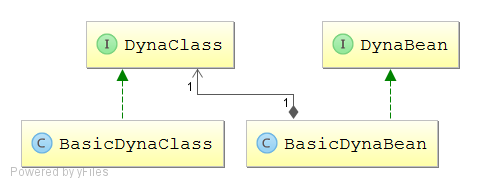Home >Java >javaTutorial >JavaBean dynamically adds and deletes attributes
JavaBean dynamically adds and deletes attributes
- 高洛峰Original
- 2016-11-22 14:36:423544browse
1.cglib
BeanGenerator beanGenerator = new BeanGenerator();
beanGenerator.addProperty("id", Long.class);
beanGenerator.addProperty("username", String.class);
Object obj = beanGenerator.create();
BeanMap beanMap = BeanMap.create(obj);
BeanCopier copier = BeanCopier.create(User.class, obj.getClass(), false);
User user = new User();
user.setId(1L);
user.setUsername("name1");
user.setPassword("123");
copier.copy(user, obj, null);
System.out.println(beanMap.get("username"));Class clazz = obj.getClass();
Method[] methods = clazz.getDeclaredMethods();for (int i = 0; i < methods.length; i++) {
System.out.println(methods[i].getName());
}
输出结果:
name1
getId
getUsername
setId
setUsernameIt can be seen from the output that the finally generated obj only has two attributes: id and username
2.org.apache.commons.beanutils
DynaProperty property = new DynaProperty("id", Long.class);
DynaProperty property1 = new DynaProperty("username", String.class);
BasicDynaClass basicDynaClass = new BasicDynaClass("user", null, new DynaProperty[]{property, property1});
BasicDynaBean basicDynaBean = new BasicDynaBean(basicDynaClass);
User user = new User();
user.setId(1L);
user.setUsername("name1");
user.setPassword("123");
BeanUtils.copyProperties(basicDynaBean, user);Map<String, Object> map = basicDynaBean.getMap();
Iterator<String> it = map.keySet().iterator();while (it.hasNext()) { String key = it.next();
System.out.println(key + ":" + map.get(key));
}
输入结果:
id:1username:name1View the relationship between BasicDynaBean and BasicDynaClass

DynaBean’s source code
public interface DynaBean {
public boolean contains(String name, String key);
public Object get(String name);
public Object get(String name, int index);
public Object get(String name, String key);
public DynaClass getDynaClass();
public void remove(String name, String key);
public void set(String name, Object value);
public void set(String name, int index, Object value);
public void set(String name, String key, Object value);
}Mainly the definition of the interface
Let’s take a look at how BasicDynaBean is implemented, directly look at public Object get(String name);
/**
* Return the value of a simple property with the specified name.
*
* @param name Name of the property whose value is to be retrieved
* @return The property's value
*
* @exception IllegalArgumentException if there is no property
* of the specified name
*/public Object get(String name) { // Return any non-null value for the specified property
Object value = values.get(name); if (value != null) { return (value);
} // Return a null value for a non-primitive property
Class<?> type = getDynaProperty(name).getType(); if (!type.isPrimitive()) { return (value);
} // Manufacture default values for primitive properties
if (type == Boolean.TYPE) { return (Boolean.FALSE);
} else if (type == Byte.TYPE) { return (new Byte((byte) 0));
} else if (type == Character.TYPE) { return (new Character((char) 0));
} else if (type == Double.TYPE) { return (new Double(0.0));
} else if (type == Float.TYPE) { return (new Float((float) 0.0));
} else if (type == Integer.TYPE) { return (new Integer(0));
} else if (type == Long.TYPE) { return (new Long(0));
} else if (type == Short.TYPE) { return (new Short((short) 0));
} else { return (null);
}
}From the above code, we can see that the value is taken from values
/**
* The set of property values for this DynaBean, keyed by property name.
*/
protected HashMap<String, Object> values = new HashMap<String, Object>();is actually implemented using HashMap.
3. Summary
When using cglib to dynamically delete and add attributes, although there is a getUsername method in obj, it cannot be called directly like obj.getUsername(). If you want to get the value of username, you can only Obtained through beanMap.get("username").
org.apache.commons.beanutils is implemented using HashMap from the source code.
The two methods are not much different from using Map from an operational perspective. Just They all provide utility methods for copying properties.

